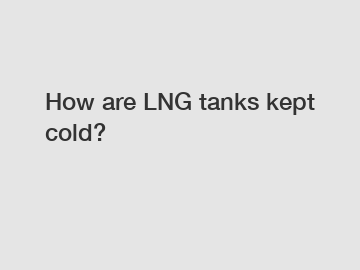How are LNG tanks kept cold?
Liquefied natural gas (LNG) has become a crucial component in meeting the world's energy demands. It is a cleaner-burning fuel compared to other fossil fuels, making it an attractive option for power generation and transportation. However, LNG must be kept at extremely low temperatures to remain in its liquid state. So, how are LNG tanks kept cold? Let's dive into the fascinating world of cryogenic technology and the innovative methods used to keep these tanks chilled.
At its boiling point, LNG is -162 degrees Celsius (-260 degrees Fahrenheit). To maintain this temperature, LNG tanks are equipped with a variety of cooling systems that work together to ensure the LNG remains in its liquid form. One of the most common methods used to keep LNG tanks cold is through the use of natural gas vaporizers and recondensers.
Natural gas vaporizers are used to warm the LNG and convert it back into a gas before it is used. By circulating warm natural gas through a series of heat exchangers, the LNG is heated and transformed into a gas that can be easily pumped through pipelines for distribution. This process helps to maintain the temperature of the LNG tank and prevent it from warming up too quickly.

Recondensers, on the other hand, are used to re-liquefy any vaporized gas that may have formed inside the LNG tank. By removing the heat from the vaporized gas, recondensers help to maintain the cold temperature inside the tank and ensure that the LNG remains in its liquid state. This process is essential for preventing the loss of LNG due to evaporation and maintaining the overall efficiency of the storage facility.
In addition to natural gas vaporizers and recondensers, insulation is another crucial component in keeping LNG tanks cold. Insulation materials such as perlite and foam glass are commonly used to prevent heat from entering the tank and causing the LNG to warm up. These materials help to maintain the cryogenic temperature required for storing LNG and ensure that the tank remains cold even in harsh environmental conditions.
Another innovative method used to keep LNG tanks cold is through the use of cryogenic refrigeration systems. These systems utilize refrigerants such as nitrogen or helium to cool the LNG and maintain its low temperature. By compressing and expanding these gases, cryogenic refrigeration systems can effectively remove heat from the LNG tank and keep the contents chilled to the desired temperature.
Furthermore, the design and construction of LNG tanks also play a significant role in keeping them cold. Double-walled tanks with vacuum insulation are commonly used to prevent heat transfer and maintain the cryogenic temperature of the LNG. These tanks are designed to withstand the extreme pressures and temperatures associated with storing LNG and are equipped with safety features to ensure the integrity of the storage facility.
Overall, the technology and methods used to keep LNG tanks cold are a testament to the advancements in cryogenic technology and engineering. By utilizing a combination of natural gas vaporizers, recondensers, insulation, cryogenic refrigeration systems, and innovative tank design, LNG storage facilities can safely and efficiently store large quantities of LNG for use in energy production and transportation.
In conclusion, the importance of keeping LNG tanks cold cannot be understated. By using a combination of advanced technology, innovative methods, and careful design, LNG storage facilities can ensure that the LNG remains in its liquid state and ready for use when needed. So, the next time you see a tank of LNG, remember the intricate processes and systems that are in place to keep it cold and keep our energy infrastructure running smoothly.
If you want to learn more, please visit our website How Does a Dewar Tank Work, Liquid Oxygen Micro Bulk Storage Tank, ISO Tank Container Sizes.

Comments